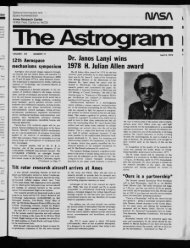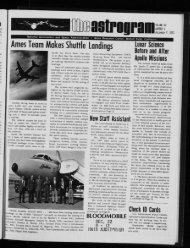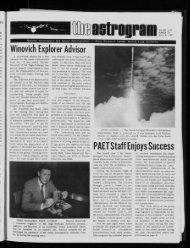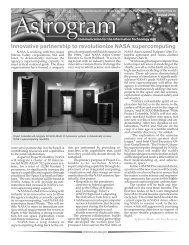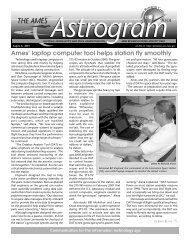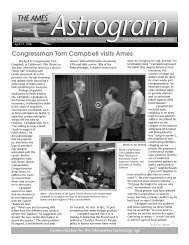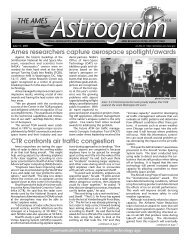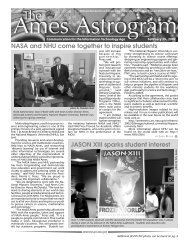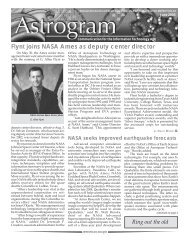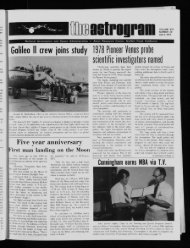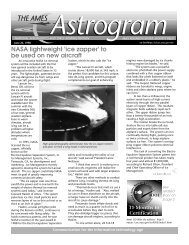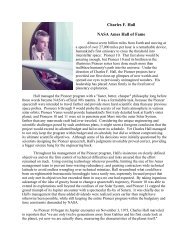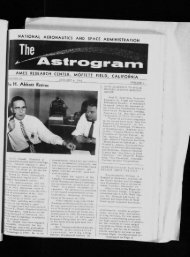3/12/01 Astrogram - NASA Ames History Office
3/12/01 Astrogram - NASA Ames History Office
3/12/01 Astrogram - NASA Ames History Office
You also want an ePaper? Increase the reach of your titles
YUMPU automatically turns print PDFs into web optimized ePapers that Google loves.
On-site Events<br />
Engineering Evaluation Laboratory hosts open house<br />
The entire <strong>Ames</strong> community is invited<br />
to a day of live demonstrations, self-guided<br />
tours and informative discussions about the<br />
most unique engineering laboratory at<br />
<strong>Ames</strong>. The open house for the Engineering<br />
Evaluation Laboratory (EEL), Code FEE, will<br />
The Impac shock machine provides<br />
impact results from dropping test items<br />
onto various density pads, producing<br />
shock pulses up to 3000g. Howard<br />
Menche, lab manager, is shown here<br />
operating the shock machine.<br />
be held in the hi-bay of building N-244,<br />
March 29, from 10 a.m. - 2 p.m. The EEL is<br />
the environmental test facility that has supported<br />
both the research and development<br />
March <strong>12</strong>, 20<strong>01</strong><br />
of hardware and the modernization<br />
of facilities at <strong>Ames</strong> for<br />
over 33 years.<br />
The EEL was originally<br />
known as the Reliability and<br />
Quality Assurance (R&QA) Lab,<br />
established in 1967 as a test<br />
facility to support the Pioneer<br />
missions. The original five pieces<br />
of equipment included a 200g<br />
centrifuge, a vibration table, a<br />
shock machine, an altitude/<br />
temperature chamber and a<br />
humidity/temperature chamber.<br />
This provided the basic<br />
environmental capabilities for<br />
the research and development<br />
of Pioneer space hardware and<br />
insured reliability and quality<br />
assurance to the final flight instruments.<br />
Since that humble beginning,<br />
EEL has acquired substantially<br />
more equipment and expertise,<br />
enhancing and expanding into many<br />
areas of engineering to assist in the development<br />
and evaluation of hardware and<br />
the instrumentation needs of many of the<br />
facilities on the center.<br />
Today, in addition to environmental testing,<br />
the EEL can also provide large-scale and<br />
small-scale strain gaging, high-precision instrumentation<br />
for mechanical and thermal<br />
quantities, structural testing of mechanical<br />
components and systems, modal analysis,<br />
specialized calibrations, mass property measurements<br />
and data acquisition and analysis.<br />
Lab staff will be on hand to demonstrate<br />
and discuss the unique capabilities of the<br />
photos by Tom Trower<br />
engineering, instrumentation, measurement<br />
and environmental concerns of customer<br />
projects. From the days of providing<br />
engineering support on flight instruments<br />
flown on Pioneer Venus and the Galileo<br />
Probe, to the ultra small strain gaging of<br />
serpentine robots or the evaluation of the<br />
frictional loads on bearings for the SOFIA<br />
telescope door, the EEL can help the <strong>Ames</strong><br />
community with its engineering test needs.<br />
If you are interested in learning more<br />
about the research and development of<br />
flight and ground-based hardware, testing<br />
in extreme environments and visiting a<br />
one-of-a-kind test facility, this open house<br />
is for you.<br />
EEL and to explore potential solutions to the BY JERRY WANG<br />
Scientists find strong evidence of microbial life on Mars<br />
continued from front page<br />
that the magnetite crystals inside the meteorite<br />
are similar to those formed by 'modern'<br />
magnetotactic bacteria now living on<br />
Earth. The team studied only single crystals,<br />
however, not the elusive chain-like structures.<br />
Friedmann's team discovered the crystal<br />
chains using a technique that enabled them<br />
to 'see' the tiny chains inside the meteorite<br />
without destroying them. Besides the chainlike<br />
formation, the team discovered that<br />
individual crystals are of similar size and<br />
shape, do not touch each other and that the<br />
chains themselves are flexible, further evidence<br />
of biological origin.<br />
"Until now, studying life has been like<br />
trying to draw a curve using only one data<br />
point --life on Earth," said Friedmann. "Now<br />
we have two data points to draw life's curve.<br />
The next step is to find the remains of the<br />
bacteria themselves,” he said.<br />
The fact that a small (about 4-pound)<br />
meteorite from a planet contains large numbers<br />
of bacteria suggests that such bacteria<br />
were widespread on the surface of Mars,<br />
according to the researchers. A stone of<br />
similar size from Earth would contain many<br />
bacteria.<br />
In addition, since magnetotactic bacteria<br />
require low levels of oxygen, this finding<br />
indicates that photosynthetic organisms,<br />
the source of oxygen in the atmosphere,<br />
must have been present and active on Mars<br />
3.9 billion years ago.<br />
"Finding evidence of life on Mars is one<br />
of the central problems in astrobiology research<br />
today," said Dr. Michael Meyer, head<br />
of <strong>NASA</strong>'s astrobiology program, which<br />
funded the research.<br />
In addition to his fellowship at <strong>Ames</strong>,<br />
Friedmann, who is best known for discovering<br />
microorganisms living inside desert<br />
rocks, is professor emeritus of biological<br />
science at Florida State University. Mem-<br />
The Ling vibration table can produce vibration levels<br />
equivalent to a space shuttle launch, or to levels matching<br />
various mission profiles. Howard Menche, lab manager, is<br />
shown here at the vibration table.<br />
bers of the research team included Dr. Jacek<br />
Wierzchos (University of Lleida, Spain), Dr.<br />
Carmen Ascaso (CSIC, Madrid, Spain) and<br />
Dr. Michael Winkelhofer (University of<br />
Munich, Germany).<br />
The meteorite ALH840<strong>01</strong> was found in<br />
the Allan Hills region of Antarctica in 1984<br />
by researchers supported by the National<br />
Science Foundation's Antarctic Search for<br />
Meteorites Program, a joint effort by the<br />
NSF, the Smithsonian Institution and <strong>NASA</strong>.<br />
The Case Western Reserve University in<br />
Cleveland manages the program.<br />
Full text of the research paper is available<br />
at: http://www.pnas.org<br />
<strong>Ames</strong> is <strong>NASA</strong>'s lead center for astrobiology,<br />
the study of the origin, evolution,<br />
distribution and future of life in the universe.<br />
<strong>Ames</strong> is the location of the central<br />
offices of the <strong>NASA</strong> Astrobiology Institute,<br />
an international research consortium.<br />
BY KATHLEEN BURTON<br />
The <strong>Ames</strong> <strong>Astrogram</strong> — 5



